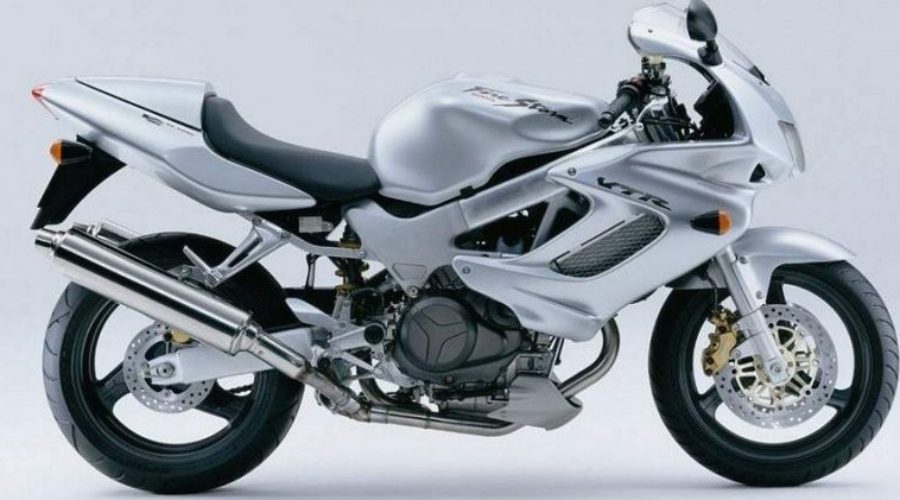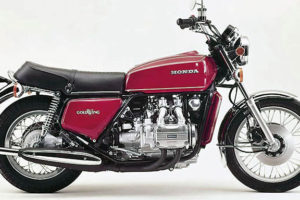1997 Honda VTR1000 Firestorm
It’s amazing the amount of interest the new generation Japanese twins have stirred up out there in motorcycle land. In nearly every place motorcyclists gather – bike shops, pubs, rallies, you name it – the air has been thick with questions, speculation and theories.
Enthusiasts seem to really want to know if these Oriental devices will set new standards for sporting motorcycles and finally offer some stiff competition to the established Italian V-twin mafia.
How’s this for an example: Nigel Patterson and I took advantage of a generous invitation from Streetwise to get some track time at one of their Eastern Creek training courses/ride days. Nige was on board Suzuki’s TL1000S and I had the VTR, and from the moment we arrived, there was a steady stream of punters approaching to study both bikes, ask questions and pass comment.
Most of the enquiries, it must be said, came predominantly from owners of Japanese four-cylinder machinery, but there was also more than a little interest shown by some members of a large Ducati contingent which was also taking part in the ride day.

On the street the story was the same. On my commute into the office and home again, some riders would edge that little bit closer for a better look while I was stopped in the traffic; others would bowl right up and start bombarding me with questions. And still others, going in the opposite direction, would do a major double-take when they realised exactly what it was they were passing.
If all that interest was to start manifesting itself in the form of people seeking test rides, I reckon dealerships would have to be open 24 hours a day to keep up with the demand!
Yet all the consumer interest and pre-release publicity in the world isn’t going mean anything if the bike turns out to be a complete lemon. Fortunately for Honda and any number of prospective customers, that’s not a concern with the VTR1000F Firestorm. It really is a well balanced and superbly integrated road motorcycle.
From the outset, Honda has been at pains to point out that the VTR1000 was designed as a sporting road bike, rather than a racetrack weapon. From what I can make out, civility and ease of use have received a higher priority than out and out performance and the ability to cut fast lap times.

Take a look at the photos and you’ll see what I mean, because the VTR’s raison d’etre is as evident in the styling as it is when you go for a ride. The VTR’s lines are rakish, suggesting speed and power, but with a curvaceous quality that softens the overall effect, imbuing a sense of stability and solidity. There’s no rawness to the VTR, none of the overtly muscular tones you’d find on something like the FireBlade. The VTR exudes controlled aggression.
Start the engine, select first gear and ride away, and that feeling of controlled aggression intensifies. Unlike many of my colleagues in the roadtesting sphere, I’ve not had much experience with sporting V twins (my CV reads one Ducati, a couple of Guzzis and the TL1000S) and often times it’s hard to understand why so many of them rave on and on about how perfect the 90-degree V-twin engine configuration is for motorcycles.
The VTR reveals all. Quite simply, it makes useable power just about bloody everywhere. Take off from idle and its there; crack open the throttle at 4000rpm and it’s there; make for a gap in the traffic and it’s there; fluff a corner on your favourite road and it’s there to get you out of trouble.

At no time does the VTR’s engine feel laboured or under pressure. Whatever you demand from it, it delivers – in great, meaty pulses of readily accessible power. On the highway, you don’t so much motor as lope along – 100km/h in top registers about 3400rpm on the tachometer. Redline is at 9500rpm, but you’re wasting everyone’s time if you visit it regularly. You’ll make much more rapid progress if you ride the VTR’s torque curve: rolling on and off the throttle as the corners dictate is an extremely relaxing way to ride fast and teaches you how to be smooth like few riding instructors can.
The carburation was almost faultless in my time with the bike, and I must admit I’d been expecting it to be a lot worse considering the enormous 48mm carbs Honda has fitted to the VTR. The factory has done its homework, however. Fuel delivery was glitch-free and the throttle response was great. My only problem was a misfire that struck briefly one afternoon on the way home from work after the VTR and I had been stuck at idle in thick traffic and hot sun for several minutes. At first I thought I’d run out of juice, but a check of the tripmeter allayed that fear. I blipped the throttle several times, and gave it a couple of good, hard tweaks in a bid to clear whatever obstruction was preventing the fuel reaching one cylinder. After an anxious moment or two, the problem disappeared and never returned. I could never quite figure out what the gremlin had been – perhaps a temporary vapour lock or ‘loading up’ caused by the excess heat or fuel starvation.
Fuel economy was pretty damn good. I averaged about 17-19km/l around town and on the open road, with a maximum figure of 16.5km/l recorded during the afternoon at Eastern Creek. This should give a range of between 260-290km from the VTR’s 16-litre tank, depending on conditions and throttle use.
The VTR’s gearbox is one of the nicest Honda boxes I’ve used. Smooth, slick shifts were the norm and except for a loud clunk whenever first was selected, there were no other noises or mechanical protestations.
The sweet engine is complimented by the VTR’s ride quality which is, in a word, beautiful. On a ride along the bumpy and very twisty McCarrs Creek Road north of Sydney, I was impressed by the composure of the chassis, which behaved impeccably despite the best efforts of the ripply tarmac to tie the bike in knots.
On standard settings, the VTR’s suspension is on the comfortable side of soft but that’s a major advantage because you never have to fight the bike to get it to do what you want it to. Both front and rear are adjustable for spring preload and rebound damping, but I didn’t bother deviating from the recommended settings on the road because there was no need.

On the track, it was a different story. All the things about the VTR’s chassis which make it such a nice road bike tend to work against it at the racetrack: that comfortable softness gave the bike a sloppy, unnervingly floaty quality at Eastern Creek, the ground clearance was limited and the high level of feedback you get on the road quickly diminished. The VTR also displayed a nasty tendency to understeer, especially in the Creek’s faster corners, and although it could be remedied by changing the rear spring preload to increase rear ride height, it took me by surprise because I had found the steering to be almost perfect on the road.
One thing that didn’t change from road to track was braking. The two four-piston Nissin calipers and floating rotors at the front do a terrific job of stopping the bike from any speed, and I found their feel and power to be right on the money. The rear brake worked as a rear brake should – not much power but very useful for keeping tabs on the rear suspension out of corners and not easy to lock up.
As I said at the start, the VTR is more a road bike than a track weapon and it could be considered unfair to criticise its performance under racetrack conditions. However, there’s no doubt that the basis is there for a more than capable track bike, and it would only take someone with the right knowledge and perhaps a few small modifications to the suspension to get the VTR up there.
From an ergonomic point of view, the VTR is multi-talented. The ride position is a good combination of sports crouch and touring comfort. You lean forward to the clip-ons but the position doesn’t put an excessive amount of weight on the wrists and, once you’re up to a reasonable cruising speed, the windblast spilling over the screen into your chest quickly negates any pressure anyway.
The seat is broad and supportive, but it slopes towards the fuel tank a little too steeply for my liking. However, good marks go to the choice of a textured, matt-finish covering fabric, which is a lot less slippery and holds its looks better than the alternative slick vinyl. Add in the good seat height/footpeg relationship (for my 180cm height, anyway) and the VTR shapes up as a pretty handy long haul or point-to-point tourer.

Not so good were the mirrors, which gave a great view of my arms and very little else, making for some nervous moments on the road when I had no idea if a copper might have been sneaking up behind me. They look great but work badly. A lack of a reserve switch on the fuel tank is also a minus point. There’s a fuel warning light on the tacho which generally comes on around 170-180km, signalling you’ve got about 2.5 litres left in the 16-litre tank.
Everything else was typical Honda: clear, easily read instrumentation; neat, accessible switchgear and a build quality of generally high standard.
So here we have a sports V-twin which goes hard, handles well, is comfortable and versatile, and nicely put together to boot. It’s made for the road and excels in that environment. It should prove reliable, I can’t see services costing a fortune and you’ll do all right at the fuel bowser as well. It even makes a pleasant noise that won’t get your crotchety neighbours in a tizz every time you wheel it out of the garage and warm it up. Even the price – $13,990 plus on road costs – looks right. Is there a catch? Haven’t found one yet …
By Pete Callaghan. Two Wheels, June 1997.

Tech and Spec
The VTR1000F’s engine uses the classic 90-degree V-twin configuration for perfect primary balance and minimum vibration. Displacement is 996cc, with four valves per cylinder actuated by chain-driven double overhead camshafts and shimmed bucket lifters. The cylinder heads are of identical casting and construction, rotated 180° for correct orientation on the respective barrels. A chain-driven water pump is located at the base of the Vee while a spin-on oil filter lives behind a moulded resin cowl on the lower crankcase.
To save weight and reduce reciprocating mass, the VTR has skirtless slipper pistons mounted on new connecting rods, which use standard threaded bolts screwed directly into tapped holes in the body of the rods to hold the endcaps. This saves a claimed 40g over a conventional bolt-and-nut combination. The connecting rods are also carburised to provide a hard and durable outer surface. The gearbox is a six-speed item mated to a 10-plate hydraulic wet clutch.

Fuel delivery is looked after by a pair of 48mm slanted flat valve downdraft CV carburettors, which are said to be the largest ever fitted to a Honda. The mixture is ignited by two NGK VX sparkplugs, controlled by an electronic ignition system incorporating throttle position and engine speed sensors. Exhaust gases are dispensed with via a stainless steel 2-1-2 system with 4.5 litre canister-style mufflers.
Twin radiators mounted on either side of the engine to save space and reduce frontal area and an oil cooler above the forward cylinder form the VTR’s cooling system. According to Honda, the radiators receive cooling air via large ports in the fairing, which create low pressure areas when the bike is at speed that literally pull the air through the radiators from the higher pressure pocket behind the front wheel. If the fairing is removed cooling efficiency is reduced substantially because the air would tend to flow around the radiators instead of through them. A fan is also fitted to the inside surface of the right-side radiator to maintain cooling in stop-start traffic.

The VTR’s ‘pivotless’ frame design uses the engine as a stressed member and has the swing-arm mounted directly to the rear of the crankcase. This was done to eliminate a major area of stress and weight in conventional frame design: the swingarm pivot plates. It also has the effect of providing a progressive amount of tuned flex in the chassis. Basically, Honda claims this means the lateral and torsional loads from the movement of the rear wheel are progressively damped out by the flex built in to the swing-arm and frame before they reach the steering head and cause instability.
To hold the swing-arm, the crankcase features large cast-in bosses, while the frame is constructed from rounded Dsection aluminium alloy spars with a dual-box cross-section for the desired blend of rigidity and flex. From the steering head, the spars and box-section engine hanger rails sweep back and merge into a large central casting surrounding the rear cylinder.
The casting also serves as a mounting point for the upper end of the rear shock and the rear subframe.
The front suspension consists of 41 mm conventional cartridgetype telescopic forks, with Honda’s Multi-Action System. Adjustment is limited to spring preload and rebound damping, both of which can be accessed at the top of the fork sliders. The rear suspension consists of Honda’s Pro-link system with a large volume 40mm damper also offering spring preload and rebound damping adjustment facilities. Instead of being linked to the lower part of the frame, the suspension’s Delta-Link is anchored, by way of an extension arm, directly to a cast aluminium bracket fixed to the lower rear portion of the engine case, which also serves as the mounting point for the sidestand.
Brakes are twin four-piston Nissin calipers acting on 296mm floating rotors at the front and a single single-piston Nissin caliper and 220mm disc at the rear. Wheels are hollow, three-spoke cast aluminium items with recommended tyre fitment sizes of 120/70ZR17 and 180/55ZR17.






